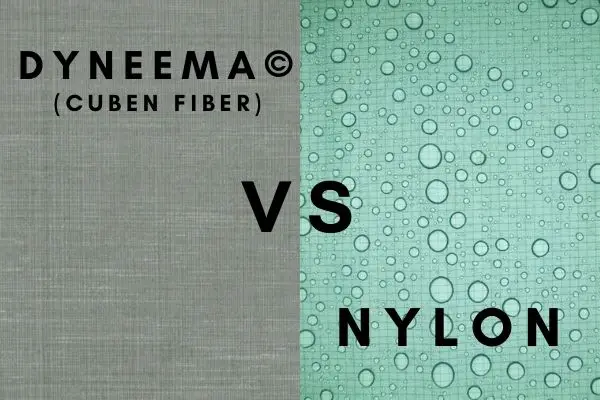Dyneema is an artificial polymer just like nylon, but it has several fundamental differences.
Both are plastics, but the manufacturing process is radically different. Nylon, as I have already written several posts about, is an amide polymer, which means it’s a long chain of monomers that can be formed into countless unique chemical structures.
The most important difference between nylon and Dyneema is that Dyneema is much lighter than nylon for the same strength. Additionally, Dyneema is unaffected by moisture and does not absorb water and expand or stretch. This makes Dyneema the superior tent material when weight is a priority.
Another important difference is that Dyneema is more expensive than nylon and its rigidity makes a tent sheet more prone to tears when subjected to a sudden impact.
Dyneema, on the other hand, is a synthetic fiber that is drawn from a polymer. The polymer is then integrated into fibers with thin mylar coatings, and what remains are ultrafine composite material that share many properties with carbon fiber. This makes Dyneema is stronger, lighter, and more durable than nylon.
If you are into ultralight hiking, Dyneema tents are definitely worth checking out as they do offer the best strength to weight ration available on top of the other benefits I will get into in this post.
Contents
What is Dyneema?
Dyneema, also known as “cuben fiber” or DCF, is an incredibly strong and durable synthetic composite fiber material. It is often used for many of the same purposes as nylon or polyester such as rope, cordage, stuff sacks, backpacks and tents. Even for rain gear! On paper it is stronger than steel and Kevlar, yet much lighter than even synthetic fabrics!
But is it really that good? I will guide you through it in this post!
Dyneema, the modern brand name of cuben fiber, was invented by the chemist Dr. Albert Pennings in 1968, but it took almost 50 years for it to become widely used in consumer products.
Cuben fiber is a strong synthetic fabric made from so called UHMWPE (ultra-high molecular weight polyethylene). As cuben fiber is made from the similar basic compound (polyethylene) as polyester, it shares many of the properties of polyester, and has some of the same shortcomings but to a much lesser extent.
Cuben fiber is actually the lightest/strongest synthetic fiber material we know of, with 15 times higher strength than steel and 1.5 times higher strength than Kevlar (the second strongest synthetic fiber), yet it weighs only 37% as much!
Dyneema can be used for anything that benefits from high strength and light weight, such as tents, backpacks, rain jackets, ropes, sails, etc.
A bit like teflon, Dyneema is also very resistant to chemicals and oils, which makes it useful for protecting clothes in the event of oil spills, as well as being resistant to sunlight. For these reasons, it is used in protective clothing, and is a component of some space suits!
Cuben fiber costs more than polyester, nylon, and even Kevlar, but as it is dropping in price, more and more outdoor brands are getting their eyes on it. And you don’t need much of it to create functional equipment.
Dyneema thread can be made down to a thickness of 10 Dtex or 9D, which is on par with the thinnest fibers of nylon. However, as we will see, Dyneema is much stronger than even nylon at twice its thickness.
What is nylon?
The fabric named Nylon is a manufactured textile made from polyamides. It was originally invented as an alternative to soft natural fabrics such as silk, which did succeed quite well!
Nevertheless, today nylon is widely used for yarn, clothing, ropes, tents, sleeping bags and also for parachutes and hot air balloons due to its light weight and high strength!
Most modern nylons used in garments and tents are made with the so-called rip-stop technique, which means that robust yarns (thicker than the main material) are woven into the fabric at regular intervals.
Rip-stop ensures that any tears of the thin main fabric should not extend along and end of ripping the whole sheet apart.
Due to its relatively low price and high functionality, nylon is the material of choice for weight critical products such as ultra light camping tents. This is because it can be made down to ultrafine threads that allows for very thin fabric to be made.
Technically, nylon can be made down to a thickness of 7D, whereas polyester can only be made to a density of 20D (almost three times as heavy!).
| Material | Grams/1000m thread | Avg. Fabric density | Water resistance (Hydrostatic Head) |
| Dyneema | NA | 17.4 g/m² | >15000 mm |
| 7D Nylon | 0.8 | 19 g/m² | 1000-2000 mm |
| 10D Nylon | 1.1 | 25 g/m² | 1000-2000 mm |
| 15D Nylon | 1.7 | 30 g/m² | 2000 mm |
| 20D Nylon | 2.2 | 34 g/m² | 3000-4000 mm |
| 30D Nylon | 3.3 | 47 g/m² | 4000-5000 mm |
| 40D Nylon | 4.4 | 54 g/m² | 5000 mmm |
| 210D Nylon | 23.3 | 70 g/m² | >15000 mm |
If you are interested, you can read more about nylon in my recent post about the different types of nylon used for tents.
Dyneema vs. Silnylon (Silicon Treated Nylon)
Silnylon is just ordinary (rip stop) nylon impregnated with liquid silicon to make it more water resistant. Silnylon is currently the most widely used fabric for ultralight backpacking gear because it is relatively strong and waterproof compared to its weight and price.
Compared to silnylon, Dyneema composite tent sheets are much stronger and more waterproof for the same weight.
For example, a tent sheet of the thinnest nylon (7D) weighs approximately 17 g/m² (.59 oz/sqyd) and the same is true for the thinnest Dyneema material (.55 oz/sqyd Dyneema®) used.
However, for the same weight and thickness, Dyneema is almost two times stronger (tensile strength of 63 lb/in) than its nylon counterpart!
Another important factor that separates nylon from Dyneema is its water resistance.
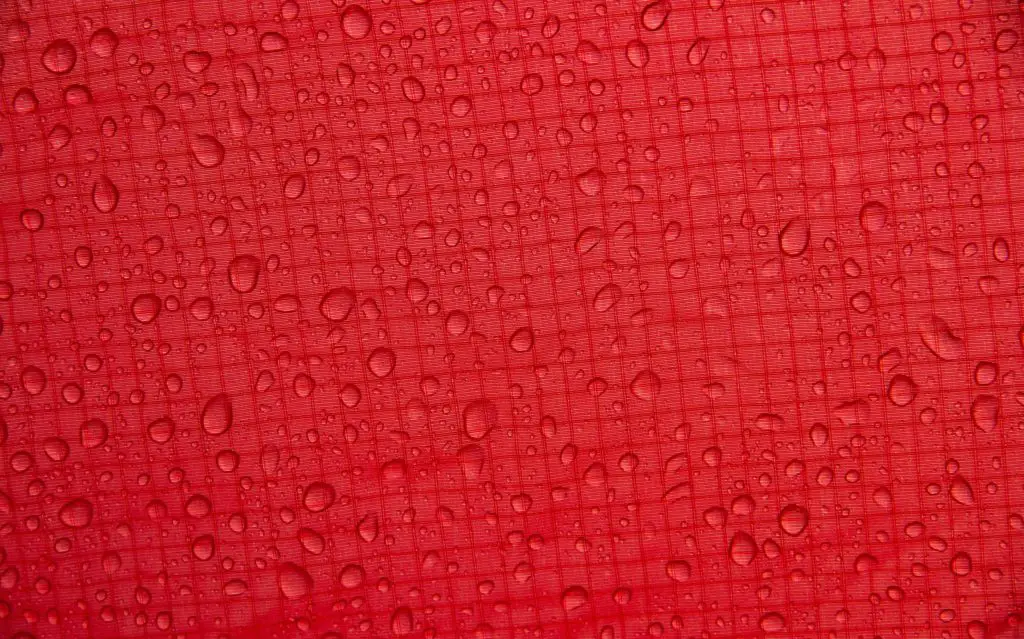
Nylon is not very waterproof in its raw untreated form, and is in fact even worse than most polyester fabrics. However, this is why silnylon was invented, but treating the nylon does not come without a cost.
Whereas silnylon is lighter than traditional tent fabrics like cotton or polyester, it is still heavier than untreated nylon and less breathable. And because the silicon treatment of silnylon is superficial, it also wears off with time, wear and UV exposure.
Because Dyneema does not require any liquid treatment to be waterproof, it does not lose its water repellent properties as easily as treated nylon does and it is quite resistant to tear and UV exposure.
A downside of Dyneema compared to nylon is that it is a much stiffer and harder material (this is way they use it in bullet proof vests!).
The density and hardness of Dyneema makes it more prone to weakening upon repeated packing and unpacking and it also renders it less breathable.
The look and feel of a silnylon tent is different than than of a Dyneema one.
Dyneema vs. silnylon for tent floors
Whereas the lesser breathability of Dyneema compared to nylon might be a problem for hot summer nights when used as tent sheets, this is not as big of a problem when Dyneema is used for the ground sheet.
For tent groundsheets, Dyneema is preferable compared to silnylon as it is stronger and more waterproof.
However, the harder Dyneema material is generally much noisier to lay on with a sleeping pad and the low elasticity can be problematic if you put your sleeping mat up against the edge.
Another downside of Dyneema is that seems are slightly harder to seal properly and that they may therefore leak with repeated use, which is not ideal for a tent floor.
This can, however, be solved by making the ground sheet as one piece.
Cordura vs Dyneema
Cordura is a nylon fabric with high resistance to abrasion. It is used for heavy jackets, pants, some tents as well as bags and backpacks.
Just like Dyneema, cordura is stronger than nylon but it is also significantly heavier than Dyneema for the same strength. But they are two materials used for different purposes.
Whereas Cordura is great for heavy duty clothing or backpacks where durability is key, Dyneema is much better for lightweight products like tents, tarps or ultralight backpacks.
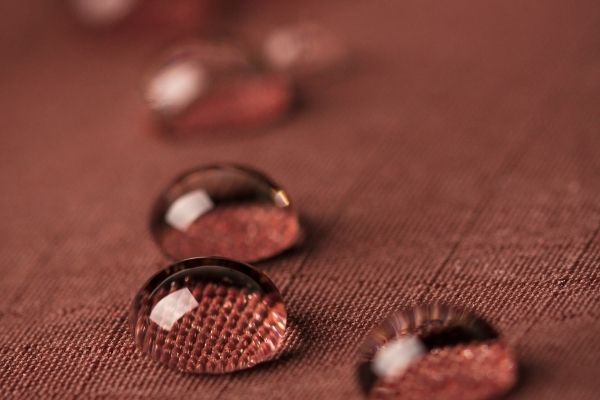
The main difference between ordinary nylon and Cordura is that the latter is much more durable as it has been specifically designed to resist abrasion and tearing. Cordura is basically thick nylon with a standard thread thickness of either 600D, 1000D or 10050D.
That is, the 1000D cordura is almost twice as thick and heavy as the 600D version.
Additionally, Cordura is also water resistant and can be treated to become fire retardant.
Cordura is sometimes a mix of nylon and other materials like cotton or kevlar to make it stronger than regular nylon (a bit like Fjällrävens G-1000 fabric!).
What are the benefits of Dyneema tents?
There are many benefits of choosing a Dyneema tent over a nylon tent. The most prominent being:
- Dyneema is strong and does not expand
- Dyneema is light
- Dyneema is waterproof
I will go over each of these benefits in more detail below.
Dyneema is the strongest tent material
Dyneema is currently considered the strongest tent material for its weight. Although thick (>30D) nylon or polyester fly sheets are also strong enough to withstand the weather all year round, these fabrics weigh significantly more than Dyneema materials of the same thickness and strength.
Dyneema is best used when strength is king. Its ultra-high molecular weight allows it to outperform almost any other manufactured fiber in its tensile strength to weight ratio.
However, it really only makes sense to use Dyneema for the ultralight category of camping gear, as the benefits are less pronounced as the material gets thicker.
For example, as nylon or polyester gets thicker, they also get more waterproof to a point where they will eventually converge with Dyneema cuben fiber.
And in that weight class, strength is no longer a problem so Dyneema does not make sense to use unless the weight is critical.
What about Zylon?
Zylon is another synthetic polymer and composite fabrics made from Zylon has shown strengths similar or higher than that of Dyneema. However, as far as I am aware of, Zylon has not yet been used in tents.
Zylon mainly differs from Dyneema in its basic chemical composition, which gives it a much higher melting point of 1112F compared to the 300F of Dyneema. However, Zylon is also much more sensitive to UV light, which breaks it down and makes it brittle, which makes it unsuitable for tent fabrics.
I also suspect that it is not yet possible to weave Zylon fabric thin enough or perhaps the reason for not using it in tents yet is that it would simply be too expensive.
Is Dyneema lighter than nylon?
Yes, for the same strength, Dyneema is around half the weight of nylon. This makes it possible to create much thinner and lighter flysheets, ropes and groundsheets for tents using Dyneema.
Normally Dyneema tents come at a higher cost, but there are budget-friendly options out there where you can still get a decent cuben fiber tent for less than 200$:
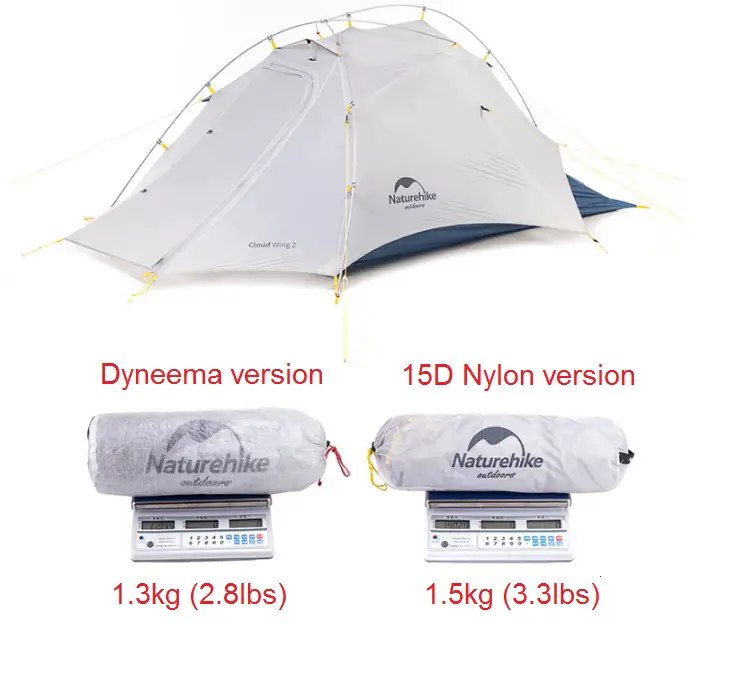
It also comes in a 15D nylon version and the Dyneema version is 5 lbs lighter and much more water resistant.
The Naturehike Cloud Wing is a good example of an affordable cuben fiber tent and is one of the few examples where they make both nylon and cuben fiber versions, so you can tell the difference.
Dyneema Fabric is Extremely Waterproof
Yes, one of the main advantages of Dyneema is its waterproof nature. Not only is it almost completely waterproof, but it also does not absorb water as nylon does.
Compared to the thinnest silicon-treated nylon sheets used for tents the thinnest Dyneema tent sheet is approximately 7-15 times more water resistant.
That is, if you want a silnylon sheet with a similar waterproof rating to Dyneema it would have to be more than 10 times thicker!
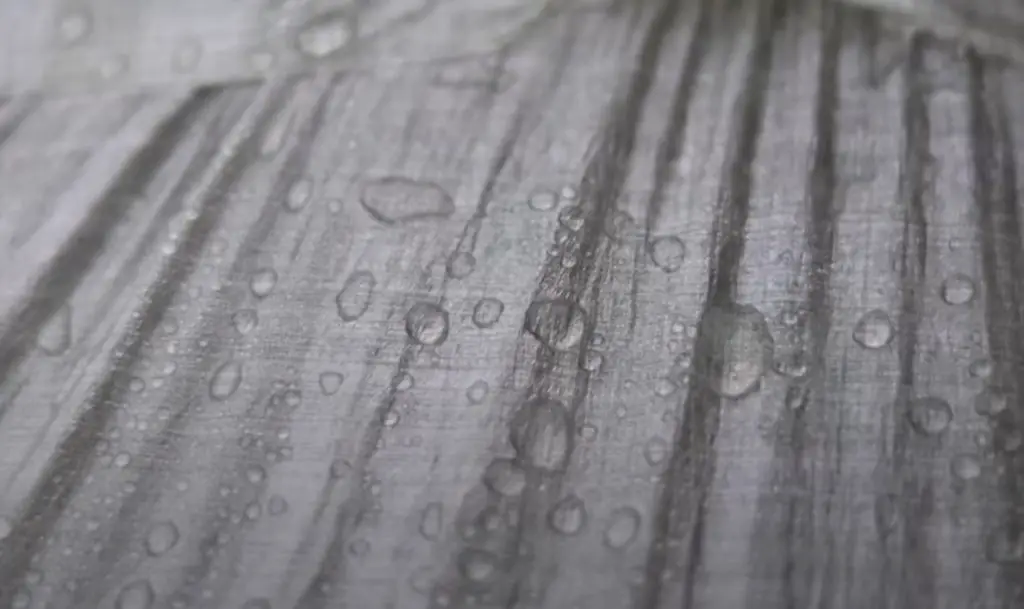
The high waterproof rating of Dyneema stems from the compact woven structure and the waterproof polyethylene (mylar) film applied on both sides.
It also has the added benefit of keeping its shape when exposed to water. This is in contrast to nylon which expands significantly when wet.
This is also a very beneficial feature for ultralight backpacks, that also benefits from the strength and waterproof rating of Dyneema.
Does Dyneema float?
Yes! In fact, Dyneema is so waterproof that you can make boats from it! And it is so light that even a sheet of cuben fiber will simply float on top of water unlike other synthetic materials like nylon and polyester.
Does Dyneema stretch?
No. Dyeema keeps its shape even when wet! This is a huge advantage when compared to other synthetics like nylon. Nylon will absorb water and this will soften, expand reduce the strength of the nylon fibers.
Cuben fiber materials like Dyneema on the other hand, do not stretch and does not expand when wet which is a huge advantage for many use cases.
Drawbacks of Dyneema Tents
Whereas Dyneema fiber definitely has its merits, it does come with some noticeable tradeoffs. Mainly:
- Dyneema is more expensive than all other tent materials
- Dyneema is less resistant to long term wear and tear
- Dyneema is less heat resistant
- Dyneema is harder to dye and wash
Why is Dyneema so expensive?
It is no secret that Dyneema fabric is much more expensive than other tent materials like nylon or polyester.
For example, the thinnest sheet of Dyneema used for tents costs approximately three times that of the same amount of the thinnest nylon sheet.
This is mainly because of the manufacturing process is much more complicated than that of other synthetic materials.
Dyneema synthetic polymers are notoriously difficult to work with. This difficulty comes in part from the molecular composition of the material.
It is very difficult to melt or dissolve these polymers, which means that both weaving and knitting processes have to be very complicated.
As an illustration, imagine trying to weave a basket out of pins. That is what a Dyneema fabric looks like when it is processed!
On top of that, to create the composite sheets used for tents, a layer of thin polyester film, called mylar, has to be fused with the woven cuben fibers to create the finished Dyneema material.
Do you know the difference between nylon and polyester and that polyester is widely used for rain gear, sleeping bags, tents, and sleeping pads?
And do you know how these materials impact the functionality?
I wrote an article about the choice of fabric and its impact on rain gear, on tents, and on sleeping pads here.
Take a look at my favorite sleeping bags or check out my post on how to choose an inflatable sleeping pad that is not noisy to sleep on.
I also recently wrote a post about the strongest nylon materials out there (some are stronger than Dyneema!).
Dyneema long term durability
Dynema tents are very strong in terms of tensile strength, meaning that the fly sheet does not tear easily upon direct pulling and when exposed to wind pressure.
However, like other fiber materials, cuben fiber does wear down locally with excessive folding and unfolding.
This means that local weaknesses might emerge in the tent fabric if stressed repeatedly in a similar manner.
So this can be prevented, and the lifespan of you Dyneema tent significantly extended, by not folding your tent in the exact same every time you pack it down.
Does Dyneema burn or melt easily?
Whereas Dyneema is flame resistant, it is not fireproof and Dyneema tent sheets will melt at around 300°F. That is actually lower than both nylon and polyester melting at around 428 F and 500 F respectively!
So if you are using your tent near a bonfire, you might be better off with nylon or polyester compared to Dyneema.
Can Dyneema be dyed?
Another drawback of Dyneema compared to synthetic fabrics like nylon and especially polyester, is that they do not dye easily.
This is why most Dyneema fiber sheets tend to have a somewhat pale tint of a dye rather than an actual strong color.
The inability of cuben fiber to retain color goes hand in hand with its water repellency. Nothing, including water, wants to stick to it and so makes painting/dyeing challenging!
Can you wash Dyneema?
Dyneema is not machine-washable and you should never put it in the dryer! However, you can rinse Dyneema with lukewarm water and soap, but do not use hot water as that may cause the material to shrink.
The good news are, that Dyneema fabrics are not likely to get very dirty and the dirt that might get attached to the fabric will be superficial and therefore easy to wash off.
This is because DCF/Dyneema is very repellent to not only water but also dirt and other stuff that may get in contact with it.
Also, because Dyneema does not easily absorb colors or other chemicals, there is no need to do a thorough wash as the filth is likely to be superficially attached.
Does Dyneema shrink?
Yes, Dyneema and other cuben fiber or DCF materials will shrink if subjected to high temperatures. Therefore Dyneema fabrics should never be put in the drier or similar.
Conclusion
Dyneema is a new type of tough, lightweight material that has taken over the market in recent years.
Nylon is still dominant for tents, however, some of the new types of Dyneema are so much stronger than nylon that I am sure we will see more hiking gear made from it!
I hope this blog post has been useful and that you have learned a bit more about Dyneema and what kind of tent to choose for your needs and budget.
If you are more interested in tent materials and ultralight backpacking. Check out my continuously updated post on my favorite cheap and lightweight tents, as well as my posts on the different types of nylon and polyester and how they compare!

